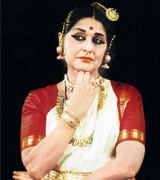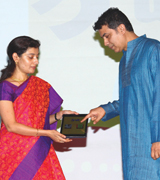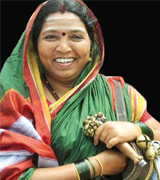COVER STORY
Pioneer and tireless champion of Mohini Attam
KANAK RELE IN CONVERSATION WITH VIJAY SHANKER

Acknowledged as a leading educationist and foremost among living Mohini Attam exponents, Dr. Kanak Rele is the only Mohini Attam dancer to be honoured with the Padma Bhushan. She is a qualified lawyer who pursued a PG course in International Law at the University of Manchester, U.K. Her passion for classical dance led her to secure a Ph.D. in Mohini Attam from Mumbai University. Kanak Rele has played a pioneering and significant role in re-establishing and popularising Mohini Attam in India and abroad, though she does not belong to Kerala, its home state. She is the Founder Director of Nalanda Dance Research Centre and Founder Principal of Nalanda Nritya Kala Mahavidyalaya established in 1972, which is affiliated to Mumbai University, and offers Bachelors, Masters and Doctrate degrees in Bharatanatyam, Mohini Attam and Kathak. She has helped to frame the syllabus for performing arts courses in numerous universities. A major initiative has been the introduction of the one year post-graduate diploma in Dance and Fitness at the University of Mumbai.
In an exclusive interview with Sruti’s Mumbai correspondent, Kanak Rele talks about her artistic journey as a dancer, dance educationist, scholar, teacher and choreographer, spanning more than six decades.
COVER STORY
A quiet glow, away from the limelight
S. JANAKI

M.K. Saroja, the veteran Bharatanatyam dancer, guru and abhinaya exponent, turns 82 this April. Saroja was the first member of her family — involved in the textile business, with no connection to the arts — to become a dancer. Born on 7 April 1931 to Rajammal and Shanmugavel Kathirvel Mudaliar, Saroja took to dancing at the age of six. She and her elder sister Selvamani were spotted by Bharatanatyam guru Kattumannarkoil Muthukumara Pillai who took the sisters under his wing. Little Saroja’s potential at once endeared her to her guru, and he adopted her as his daughter. The sisters made their debut, though not formally, in 1938. Travelling back in time, Saroja recalls her guru with affection: “With his patience and love, treating us like two dolls, our Guru made us love dance so much that it became our life.”
Muthukumara Pillai took Saroja and Selvamani to many villages to perform Bharatanatyam. Later, Selvamani stopped performing, but continued to teach and do nattuvangam. Saroja continued her training, started giving solo performances from the age of nine, and soon became famous as Baby Saroja. When Muthukumara Pillai was invited by celebrated dancer Ram Gopal to teach in his dance school in Bangalore, he wanted to take little Saroja along so that her dance classes could continue. So her entire family moved to the garden city from Madras. Impressed by Saroja’s talent, Ram Gopal inducted her into his troupe. She toured extensively with the group for three years and was presented everywhere as a star performer.
NEWS & NOTES
Just a flick of a finger away
SAMUDRI

Beautiful kolams and creative way-signs combining jute and traditional tombais lined the path to the Rukmini Arangam at Kalakshetra, in Tiruvanmiyur. A packed auditorium greeted the speakers and performers at the launch of the Sruti App on 15th March in Chennai.
The proceedings commenced with Sruti editor-in-chief V. Ramnarayan’s welcome address. He mentioned how Sruti had always maintained a fine balance between tradition and innovation. “Sruti has always been steeped in tradition, but never shied away from technology; it has used contemporary tools to analyse our ancient arts. The Sruti website was launched as early as 1998, by the venerable doyen of Carnatic music, Semmangudi Srinivasier, another happy juxtaposition of tradition and modernity. Another step forward was when the magazine introduced colour in late 2006, and the Sruti blog is now a lively adjunct to the magazine.”
ISSUES
Gone with the devadasis
SAKUNTALA NARASIMHAN

Music aficionados in Bangalore were treated on 31 January 2014 to a day-long discussion and documentary film on the Devadasi tradition of the north Karnataka-Maharashtra border areas with a focus on the music of the devadasis, something that our cultural heritage lost with the “cleaning up” of the tradition of devadasis in the post-war years. We came away from the film show and the discussions that followed, pondering the cultural entities that got snuffed out and jettisoned during and after colonial rule, in the name of “modernity”.
Devadasis, literally meaning “dedicated to the service of God,” were women artists and an essential part of temple ensembles, particularly in south India. Their song and dance recitals were part of the rituals of worship offered to the deities; and this meant that in a social milieu the homemaker women, especially from the upper castes and communities, were not allowed to take to music or dance as a full time pursuit. It was the devadasis who kept alive and nurtured music and dance traditions. In the north, likewise, the tawaif, or courtesans, were the custodians of the thumri and dadra genres, and nobility used to gather at their kothis to listen to their renderings, despite their homes being known as “houses of ill repute”. They never married, as devadasis were said to be married to God. Over time, thanks to the spread of Western ideas and culture, and the degeneration of the institution of devadasis into women recruited as mistresses by the wealthy, they came to be seen as outcastes, and as disreputable women. The word “thevadiyal”, a corruption of “devar-adiyaal” or devadasi, is to this day a word of abuse in Tamil. The British brought in legislation outlawing the system of dedicating girls to temples as devadasis, but remnants of the custom linger.


